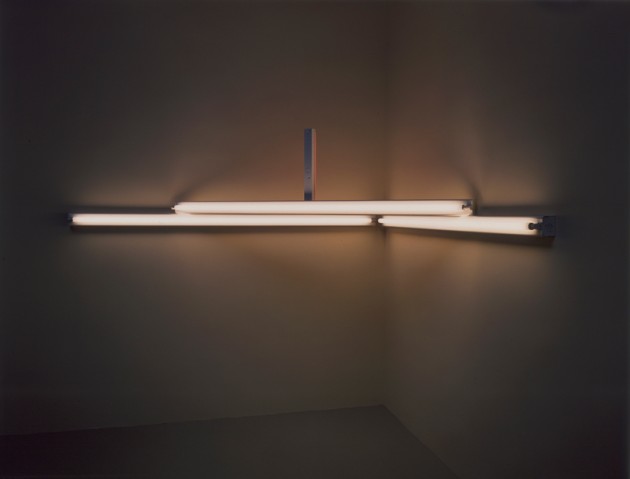"monument" on the survival of Mrs. Reppin: An Artwork by Dan Flavin
Most artists shy away from the corners of exhibition spaces, preferring their artwork to be placed front and center on the gallery wall. This is not the case for Dan Flavin (American, 1933–1996), who, through the use of light, often installed his artwork in nooks and crannies to call attention to architectural idiosyncrasies.
Through his study of art history, Flavin became enamored with Russian Constructivist Vladimir Tatlin’s use of gallery corners to exhibit artwork. Tatlin’s corner reliefs, first exhibited in 1915, did away with frames and projected into real space. This use of the corner, along with Tatlin’s use of building material to convey revolutionary social and political attitudes, drew Flavin’s interest. Flavin not only looked to Tatlin’s Monument to the Third International for the titling of his own “monuments...” but also may have been intrigued by the idea that in a traditional Russian home, the corner is typically occupied by a religious icon.
Along with such artists as Donald Judd, Sol LeWitt and Carl Andre, Flavin became one of the progenitors of minimalist art. Though these artists eschewed such a label, it did describe their efforts to remove ornamentation and boil down the art to the essence of their ideas. To further this concept, Flavin used the term exposition, as opposed to exhibition, because the former term implied a concept behind what was exhibited, rather than mere display.
In 1962, Flavin made a creative breakthrough with his “icon” series. These memorials used light and paint together and served as the first step toward the artwork for which Flavin became well known. These icons are square, painted surfaces (usually monochromatic) that incorporate lit light bulbs of various dimensions and are dedicated to the memory of lost friends or influences—often people Flavin knew, and occasionally art historical or literary references.
Flavin’s first artwork made exclusively from a fluorescent tube was diagonal of personal ecstasy (the diagonal of May 25, 1963). This significant step away from traditional art mediums such as painting or drawing was a personal breakthrough for Flavin because it incorporated the idea of the readymade, employed and perfected by Marcel Duchamp years earlier, with the idea of the “endless column” used by Constantin Brancusi. The availability of physical materials, combined with the theoretical endlessness of fluorescent light as a standard unit, captivated Flavin for much of the remainder of his career.
“monument” on the survival of Mrs. Reppin has all of the characteristics that make an artwork by Flavin so recognizable—the materials, the engagement with the exhibition space and the idea of a corner icon. Fluorescent lights spanning the corner project light from the sculpture and occupy the gallery to its fullest—illuminating both the corner and the adjacent walls and gallery space.
The idea of making the corner a site for a family’s religious memorials and icons may have led Flavin to install “monument” on the survival of Mrs. Reppin in this manner. In 1966, while in Germany planning his exhibition at the Galerie Rudolph Zwirner, Flavin met Mrs. Reppin, Zwirner’s mother-in-law. A British citizen living and married in Germany, she had been interned by the Allies for not divorcing her husband, who was a German soldier during World War II.
Acquired in 1969 by the Fellows Acquisition Fund for the Pasadena Art Museum, “monument” on the survival of Mrs. Reppin has never been on display in these galleries. At the time the artwork was acquired, the building at the corner of Orange Grove and Colorado Boulevards was being constructed. The interior walls matched the shape of the exterior ones, so there were only rounded galleries—no corners. It was impossible for the artwork to be installed as the artist had envisioned it—that is, until the interior gallery renovations in 1999. This piece, conceived and fabricated in Germany and fitted for European voltage, was recently conserved and retrofitted with components that work with standard U.S. electrical circuits. The Norton Simon Museum has been in close communication with the Estate of Dan Flavin during the work’s conservation and is pleased to be able to exhibit “monument” on the survival of Mrs. Reppin in its galleries.

 , 1966
, 1966